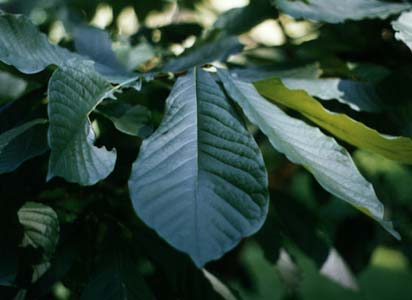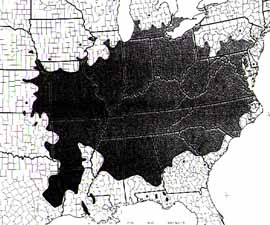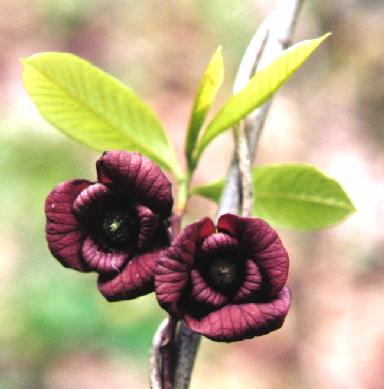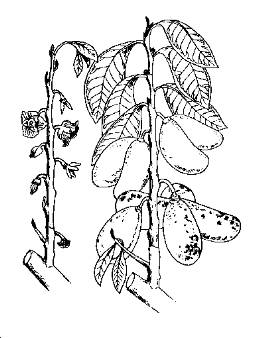Asimina triloba - Pawpaw or Michigan banana)
Food for the Zebra Swallowtail butterfly.

Pawpaw - Asiminia triloba
Family: Annonaceae
Form: Understory tree, upto 30 feet tall
Leaves: Large 7-10 inch long elliptical to oblanceolate
Twigs / buds: Stout twigs, naked buds covered with reddish hairs
Bark: Smooth brown
Fruit: Edible berry, 3 to 5 inches long
Other: Fruit is good and is gaining popularity
Range

![]()
I planted 3 in Spring of 1998
![]()
The pawpaw is a small tree or shrub native to North America. The tree produces a fruit, also called a pawpaw. The fruit looks somewhat like a thick, short banana. The plant is found in the southern U.S. and as far north as Kansas, Michigan, New Jersey and western New York. Its leaves spread out in umbrellalike whorls, as do those of some species of the magnolia. However, when the leaves are bruised they give off a disagreeable odor.
The pawpaw grows from 10 to 40 feet high and bears fruit 2 to 6 inches long. The fruit has a greenish-brown skin. The yellow pulp is soft and sweet, but does not have enough taste to make it popular as a table fruit. The fruit falls to the ground in autumn and must be stored until ripe. It may be baked into pies, made into dessert, or eaten raw with cream as a breakfast food. When eaten raw it is cloyingly sweet with a custard-like flavor. Seemingly a taste for it must be cultivated because some consider it nauseating. The food value is largely carbohydrate. Handling the fruit is known to produce a skin rash on some people. Birds are fond of the fruit, and it is also eaten by gray fox, opossum, raccoon, and squirrel. The fruit has the same nutrient value as the banana.
Flowers of the Pawpaw are pollinated by flies. To insure pollination, road kill is often collected and hung in trees of commerical plantings to attract flies. The seeds of the Pawpaw contain an alkaloid, asiminine, which is reported to have emetic properties. The bark was once used as a medicine, and contains the alkaloid analobine. The wood of the tree is too soft and coarse to be valuable. The thin fibrous bark may be used in making fish nets. The American pawpaw belongs to the custard apple family, Annonaceae. It is genus Asimina, species A. triloba. It is usually an understory tree grown in bottomland areas of acidic soils and high rainfall.
![]()
This is a low-growing shrub or small tree that is fairly common in Kentucky. It is usually found on wooded slopes, near streams, and in marshy areas. The plant blooms in April and May, producing large, maroon to brown colored flowers, which are followed by an edible fruit in the summer which has a taste reminiscent of bananas.

![]()
A clonally-reproducing small tree found in the understory of rich sites on poorly to well drained, moist soils. Very tolerant of competition. Ecology: An indicator of rich sites, pawpaw occurs in the understory in river banks, coves and lower slopes, extending onto drier sites nearby. It occurs in clumps of shrubs or small trees. Life History: Reproduces clonally and less often from seed, forming patches in the understory. Bears large, but not showy, purple, perfect flowers in late spring. Fruit ripens in late summer. Typically a small understory tree, reaching 30' x 6".
Also called possumhaw, this is a favored fruit of possums, raccoonns, foxes and other mammals. The fruiting season is short, and competition for fruit is intense.
![]()
A small tree on rich bottomland soils of the central eastern states. Leaves are simple, deciduous, alternate, narrowly obovate, entire, and papery. They are 2-ranked and emit a strong tomato or green pepper smell when crushed. Twigs have naked, red-brown hairy buds. Fruit is a large (about 4"), irregularly cylinder-shaped, aromatic, green (becoming yellow and then black), somewhat banana-like edible berry that matures in late summer or early fall. Bark is thin, smooth, dark brown, and often with gray blotches and small wart-like projections on older trees.
![]()
Not long ago, the pawpaw was known only as the subject of a traditional children's folk song, and through the reminiscings of old-timers who recalled the 30 or so cultivars popular just after the turn of the century. But the pawpaw has once again come into the limelight and is quickly reclaiming its place in garden and backyard orchard.
And deservedly so. Consider these attributes: it's easy to grow, it's hardy to zone 5 (at least), it's an ornamental tree with a tropical appearance and it has interesting flowers that are up to two inches across. Then there's the delicious fruit that tastes like a cross between bananas and vanilla custard, and it has a vitamin content that rivals citrus--all this wrapped up in one small package! That's Asimina triloba, the pawpaw.
One of first recorded historical references
to the pawpaw, which incidentally is the largest native fruit in North America, dates back
to De Soto's expedition of 1540. He wrote of Native American's cultivating the pawpaw and
later introduced it to the Europeans. In 1736, botanist John Bartram sent some pawpaw
specimens back to England. Not much was done with pawpaws during the 1800's, but after the
turn of this century, interest swelled. And during the great depression, many people
supplemented meager diets with the pawpaw.
But after World War II, imported fruit became easily obtainable and interest in pawpaws
waned.
Taxonomically speaking, the pawpaw is a member of the Annonaceae family. The same family that is home to the tropical fruits soursop, custard apple and the cherimoya--which is becoming available at many grocery stores.
Pawpaw trees are not as difficult to grow as some people may have thought in the past. They can be finicky, but if you follow a few basic rules you are likely to succeed--and be rewarded with bushels of delicious fruit! They prefer a slightly acid soil, pH 5.5-7.0. The soil should be well drained and fertile. If your site is in full sun, you can expect the tree to take on a narrowly pyramidal shape with dense drooping foliage down to the ground level. Grown in the shade, the habit is more of an open branching with few lower limbs and horizontally held leaves. Paw paws are typically small trees, seldom reaching over 25 feet in height. Several trees should be planted as most are self-infertile.
As if it didn't have enough going for it, research is underway to isolate compounds from the pawpaw's twigs which appear to have promising benefits in cancer therapy. Other compounds from the pawpaw are being tested as organic pesticides. One extract has been able to kill pests such as harmful nematodes, tobacco horn worms, bean beetles, potato bugs and cabbage loopers.
If you're ready to grow pawpaws, I suggest that you join the Pawpaw Foundation. In addition to keeping you informed about new developments in the culture of Pawpaws, you will be provided with information on purchasing trees and the ability to network ith the experts in the field.
You can contact the Pawpaw Foundation at:
The PawPaw Foundation
c/o Dr. Desmond Layne
129 Atwood Research Facility
Kentucky State University
Frankfort, KY 40601
Phone:502-227-5942
Email: dlayne@uky.campus.mci.net
Other Contacts
Jill Vorbeck
North American Fruit Explorers
Rt 1 Box 94
Chapin IL 62628
Phone: 217-245-7589
Dr. Desmond Layne
KSU 129 Atwood arch
400 E Main
Frankfort KY 40601-0091
Email: dlayne@ca.uky.edu
Phone: 502-227-5942
Fax: 502--227-6381
![]()
PAWPAW

Asimina triloba
Annonaceae
Common Name:Pawpaw, Paw Paw, Papaw, Poor Man's Banana, Hoosier Banana, etc. (In Australia the tropical papaya, Carica papaya, is also known as Pawpaw).
Related species: Asimina incarna, A. longifolia, A. obovata, A. parviflora, A. pygmaea, A. reticulata, A. tetramera, A. X nashii. These eight Asimina species grow in the southeastern United States.
Distant Affinity: Cherimoya (Annona cherimola), Soursop (Annona muricata), Custard Apple (Annona reticulata), Sugar Apple, Sweetsop (Annona squamosa), Atemoya (Annona squamosa X A. cherimola).
Origin: The pawpaw is native to the temperate woodlands of the eastern U.S. The American Indian is credited with spreading the pawpaw across the eastern U.S. to eastern Kansas and Texas, and from the Great Lakes almost to the Gulf. Fossils prove the pawpaw is indigenous to the U.S.
Adaptation: The pawpaw is adapted to the humid continental climate of its native habitat. It is seldom found near the Atlantic or Gulf coasts. It requires a minimum of 400 hours of winter chill and at least 160 frost-free days. Pawpaws appear to be sensitive to low humidities, dry winds and cool maritime summers. It has been successfully grown in parts of California and the Pacific Northwest that meet its growing requirements. It has grown well in the San Jose area (USDA Climate Zone 9 or Sunset Climate Zone 15). The climatic conditions of Southern California make growing the pawpaw there more difficult. The deep winter dormancy of the tree makes it highly frost tolerant, withstanding temperatures of -25° F or lower (hardy to USDA Climate Zone 5). Pawpaws can be grown as container specimens, although this is not often practiced. A deep pot is needed to accommodate the root system.
DESCRIPTION
Growth Habit: The pawpaw is a deciduous, often narrowly conical tree growing from about 12 feet to around 20 feet. Pawpaw trees are prone to producing root suckers a few feet from the trunk. When these are permitted to grow, the single-clone pawpaw patch comes into being. The prevailing experiences of many individuals is that the pawpaw is a slow grower, particularly when it is young. However, under optimal greenhouse conditions, including photo-period extension light of approximately 16 hours, top growth of up to 5 feet can be attained in three months.
Foliage: The dark green, obovate-oblong, drooping leaves grow up to 12 inches long, giving the pawpaw an interesting tropical appearance. The leaves turn yellow and begin to fall in mid-autumn and leaf out again in late spring after the tree has bloomed.
Flowers: Dormant, velvety, dark brown flower buds develop in the axils of the previous years' leaves. They produce maroon, upside-down flowers up to 2 inches across. The normal bloom period consists of about 6 weeks during March to May depending on variety, latitude and climatic conditions. The blossom consists of 2 whorls of 3 petals each, and the calyx has 3 sepals. Each flower contains several ovaries which explains why a single flower can produce multiple fruits.
Fruit: The pawpaw is the largest edible fruit native to America. Individual fruits weigh 5 to 16 ounces and are 3 to 6 inches in length. The larger sizes will appear plump, similar to the mango. The fruit usually has 10 to 14 seeds in two rows. The brownish to blackish seeds are shaped like lima beans, with a length of 1/2 to 1-1/2 inches. Pawpaw fruits often occur as clusters of up to nine individual fruits. The ripe fruit is soft and thin skinned.
CULTURE
Location: The young plant is very sensitive to full sunlight and requires filtered sun for the first year or two. The use of tree shelters is an ideal solution to the problem, permitting the plant to receive a full day of filtered sunlight. Once established, pawpaws prefer full sun. The large dangling leaves dislike strong winds. Overall the tree is an excellent edible landscape addition.
Soil: Pawpaws do best in deep, fertile soil that is moist, but well-drained and slightly acid (pH 5-7). The addition of compost to most western soils makes them more hospitable to the pawpaw. Avoid heavy, wet, alkaline soil.
Irrigation: The pawpaw needs regular watering during the growing season. The soil should be kept moist but avoid waterlogging.
Fertilization: The pawpaw responds to the application of an organic or granular fertilizer high in potassium twice a year. For container growing, 250 - 500 ppm of soluble 20-20-20 NPK plus soluble trace elements during growth phase is optimal.
Pruning: Ordinarily little pruning is required, except to remove dead, damaged or wayward branches. Periodic pruning may be used to stimulate some new growth each year on older trees, since it is new growth that produces fruit the following season.
Propagation: To break dormancy Pawpaw seed must receive a 90 to 120 day stratification, i.e. exposure to cold temperatures. To accomplish this, the seed should be placed in plastic freezer zipper bag containing a handful of moist sphagnum moss and refrigerated at 32° - 40° F. The over wintering of field planted seeds normally accomplishes this stratification requirement.
Germination of pawpaw seed is hypogeal--the shoot emerges without any cotyledons. Under ideal greenhouse culture, germination can be expected in about seven weeks. Seeds field-planted in the fall will emerge the following July or August. But before the shoot emerges, the seed will have sent down a 10 inch long tap root.
Hardwood cuttings are essentially impossible to root, while root cuttings have been variable to disappointing. Some success has been reported using softwood cuttings under intermittent mist with bottom heat (80° F) and supplemental light (14 hours). All grafting and budding techniques can be performed on the pawpaw, but T-budding is not recommended. Chip-budding has been reported to be successful. Scion wood should be gathered while the tree is dormant and kept refrigerated. Grafting can be done in the spring after vegetative growth begins.
Young pawpaw plants have fleshy, brittle roots with few fine root hairs, making them difficult to transplant. It is important to follow these helpful rules:
- Use seedlings, not root suckers.
- Move the tree with roots and soil intact. A container grown specimen is best.
- Transplant the tree in the spring after bud break.
- Give the plant good drainage and keep it well watered the first year.
Pests and diseases: Pawpaw trees are relatively disease free, including a resistance to Oak Root Fungus (Armillaria). A number of vertebrates such as foxes, opossums, squirrels and raccoons will eat the fruit, although deer, goats and rabbits will not eat the leaves or twigs. The attraction of pawpaw roots to gophers is a somewhat unknown factor, but it seems likely that they would not be the gopher's first choice. The Zebra Swallowtail butterfly's larvae feed exclusively on young, pawpaw foliage, but never in great numbers. On the West Coast, slugs, snails and earwigs can be easily controlled by the application of Tanglefoot to a band around the pawpaw tree trunk. It is important not to apply Tanglefoot directly to the bark, however.
Pollination: Poor pollination has always plagued the pawpaw in nature, and the problem has followed them into domestication. Pawpaw flowers are perfect, in that they have both male and female reproduction parts, but they are not self-pollinating. The flowers are also protogynaus, i.e., the female stigma matures and is no longer receptive when the male pollen is shed. In addition pawpaws are self-incompatible, requiring cross pollination from another unrelated pawpaw tree.
Bees show no interest in pawpaw flowers. The task of pollenization is left to unenthusiastic species of flies and beetles. A better solution for the home gardener is to hand pollinate, using a small, soft artist's brush to transfer pollen to the stigma. Pollen is ripe for gathering when the ball of anthers is brownish in color, loose and friable. Pollen grains should appear as small beige-colored particles on the brush hairs. The stigma is receptive when the tips of the pistils are green, glossy and sticky, and the anther ball is firm and greenish to light yellow in color.
Harvest: Pawpaw fruit ripens during a four-week period between mid August and into October, depending on various factors. When ripe, it is soft and yields easily to a gentle squeeze, and has a pronounced perfumed fragrance. The skin of the green fruit usually lightens in color as it ripens and often develops blackish splotches which do not affect the flavor or edibility. The yellow flesh is custard like and highly nutritious. The best fruit has a complex, tropical flavor unlike any other temperate zone fruit. At present, the primary use of pawpaws is for fresh eating out of hand. The ripe fruit is very perishable with a shelf life of 2 or 3 days, but will keep up to 3 weeks if it is refrigerated at 40° - 45° F.
Commercial potential: Although pawpaw fruit is not yet a commercially viable commodity, the domestication process is well underway. Several academic institutions are setting up seventeen Regional Variety Trial sites. Kentucky State University is the site of Pawpaw National Clonal Germ-plasm Repository. The pawpaw has also found its way to several overseas countries, and a few of these are actively engaged in research. Pawpaw leaves and twigs contain substances with promising anti-cancer and pesitcidal properties.
Plant selection: A number of mail-order sources of pawpaw plants now offer both grafted cultivars and seedlings. Most seedling plants have been propagated from mixed seeds and will eventually end up producing undesirable fruit. Purchasers are advised to graft such plants to a known cultivar or order grafted plants initially. Container grown plants are much more likely to survive transplanting.
When placing an order for a pawpaw plant, it is helpful to have the Pawpaw Selection Option Chart below handy. Phoning in the order gives the opportunity to ask questions and substantiate it.
| PAWPAW PLANT SELECTION OPTIONS | ||
|---|---|---|
| Container Grown (1) | Bare Root (2) | |
| CULTIVAR - on seedling root stock | some sources | most sources |
| CULTIVAR - from shoot/root on own root stock | rarely available | rarely available |
| SEEDLING - from seed of mixed seed (risky fruit quality) | some sources | most sources |
| SEEDLING - from seed of cultivar fruit (usually comes fairly true) | rarely available | rarely available |
| (1) easier to get established, good survival rate (2) slower to get established, reduced survival rate |
||
CULTIVARS
Callaway (1990) lists over 60 pawpaw cultivars, many of which are not available in the nursery trade. The following cultivars are among the best with regard to fruit quality:
- Davis
- Fruit small. Flesh yellow, green skin. Seeds large. Flavor good.
- Mary Foos Johnson
- Similar to Sunflower.
- Mitchell
- Fruit medium. Flesh golden, slightly yellow skin. Flavor excellent.
- Overleese
- Fruit large. Fewer seed but large. Flesh yellow. Flavor excellent.
- Prolific
- Fruit large. Flesh yellow. Flavor excellent.
- Sunflower
- Fruit medium large. Flesh golden, yellowish skin. Few seeds. Flavor good. Purported to be self-fertile.
- Sweet Alice
- Fruit medium large. Prolific bearer. Flesh yellow. Flavor good.
- Taylor
- Fruit small. Flesh yellow, green skin. Flavor mild, excellent.
- Taytoo
- Fruit medium. Flesh yellow, light green skin. Flavor excellent. Prolific bearer.
- Wells
- Fruit quite large. Flesh orange, green skin. Flavor superb.
FURTHER READING
- Callaway, M. Brett. Pawpaw (Asimina triloba): a "Tropical" Fruit for Temperate Climates. New Crops. 1993.
- Callaway, M. Brett. The Pawpaw (Asimina triloba). Kentucky State University, Frankfort, KY. 1990.
- Callaway, M. Brett and Dorothy J. Callaway. Our Native Pawpaw: The Next New Commercial Fruit? Arnold Arboretum, Harvard University. Fall 1992, pp 20-29.
- Layne, D. R. Pawpaws. In: Register of Fruit and Nut Varieties, 3d ed. A.S.H.S. Press, Alexandria, VA, 1996.
- Layne, D.R. The Pawpaw [Asimina triloba (L.) Dunal]: A New Fruit Crop for Kentucky and the United States. HortScience vol. 31, 1996, pp. 15-22.
- Peterson, R. Neal. Pawpaws in the Garden, and Pawpaws in the Nursery Trade. Pawpaw Foundation, 1990.
- Peterson, R. Neal. Pawpaw (Asimina). Acta Horticulture, ISHS. Feb.1991, pp. 569-600.
- Reich, Lee. Uncommon Fruits Worthy of Attention. Addison-Wesley, 1991. pp. 3-13.
See Index of CRFG Publications, 1969 - 1989 and annual indexes of Fruit Gardener for additional articles on the pawpaw.
Here is the list of additional CRFG Fruit Facts.
© Copyright 1996, California Rare Fruit
Growers, Inc.
 Wildflower
Seed For Sale
Wildflower
Seed For Sale